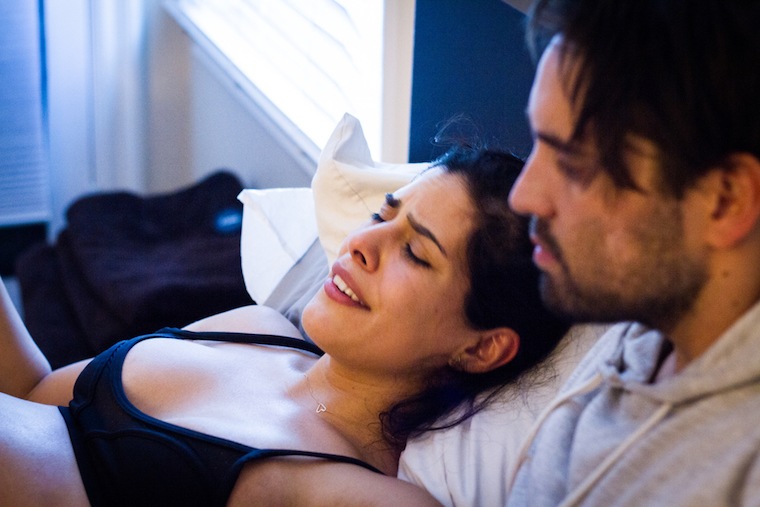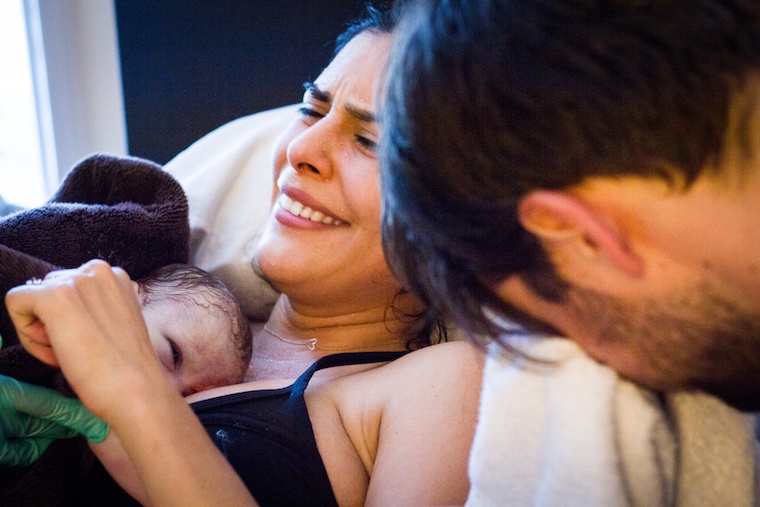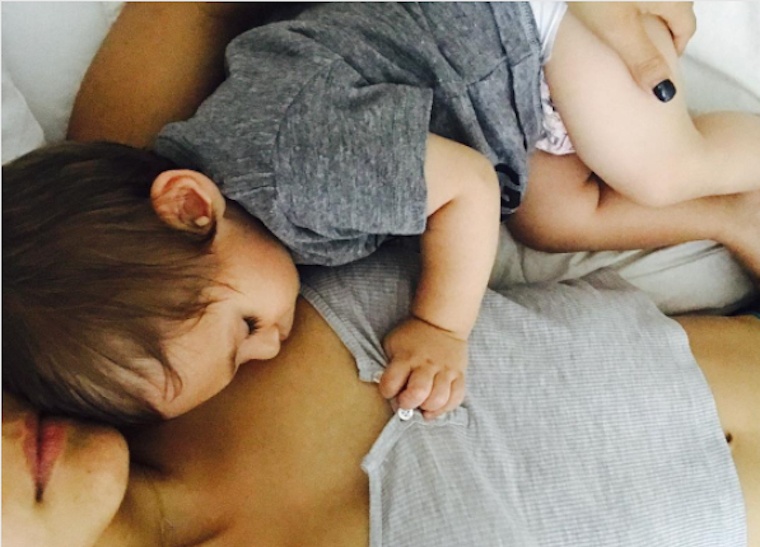Why I Chose to Have a Natural Breech Birth at Home—and Would Do It Again
You might know Jeannette Ogden better by her Instagram handle, @shutthekaleup. It's where the SoCal yogi documents her life, morning smoothie game (gotta love a healthy gal who knows her way around a high-speed blender), as well as what it's like to be a new mom—her son Elliott was born in December 2015.
From the point she found out she was pregnant, Ogden says she knew she wanted to work with a birth center and bring her baby into the world at home, naturally (i.e. no painkillers). And with two weeks left until her due date, everything looked to be going according to plan...until her baby did an about face and Ogden had to make a decision: have a home birth anyway or head to the hospital.
Here, she explains her choice to stay in bed and have her breech baby naturally—and why she'd totally do it again.
At the very end of my pregnancy—about 38 weeks—my midwife felt Elliott, and he’d turned. All of a sudden, he was no longer facing down like a normal baby would be—he was breech. And it became very stressful, having a birthing plan for nine months and then someone telling you, “Oh my gosh, you’re going to have to go to a hospital and get a C-section.” We were all good, everything was perfect, and then emergency C-section? I just remember thinking, “This can’t be real.”
Having a birthing plan for nine months and then someone telling you, “Oh my gosh, you’re going to have to go to a hospital and get a C-section.” It was kind of like, “What the hell happened?”
Birth centers don’t do breech births because it’s illegal in California—unless you have a specialist that’s able to perform this kind of birth. My husband, AJ, and I tried to keep our composure and did research to figure out how we could still have this baby: either flip him, have a home birth, or hospital birth but still natural—some way to stick with our original birthing plan.
To be clear, it’s not that C-sections are bad, but I wanted my skin-to-skin [moment]. It just terrified me—the thought of Elliott being held by this doctor that literally cut me open and I’m super drugged up and so is he.
In the end, we did find a specialist—his name is Dr. Stu Fischbein. He’s actually a legend, and he's one out of two specialists who's still able to perform breech births in Southern California. We made an appointment to basically see how everything looked in my belly. He checked me out, we talked, and come to find out I was a perfect candidate because Elliott was Frank breech—this means that his little legs were literally on his face. He wasn’t going to move anymore—his butt was going to come out first.

We met up with Dr. Fischbein on Monday, and he told us, “Okay, if we’re doing this, I need to go over to your house on Wednesday to make sure that it’s a safe place and that you’ve got a good place to birth this baby.”

{{post.sponsorText}}
So he comes and checks out our place, and he's like, "This looks perfect: You have towels, you have pots and pans to get our hands dirty, and we’re good to go." Then he says to me, “To be completely honest, you’re in your birthing stage now. I can see it in your face.”
My water broke, but I thought I had just peed myself, because when you’re pregnant, you know, that just happens. It’s totally normal.
And at that time, I did feel different. I felt like I was getting a lot of Braxton Hicks, which are little baby contractions. But I was still like, “There’s no way.” He said, “Yeah, you’re probably going to end up calling me tonight or tomorrow.” And then he left.
Sure enough early the next morning, my water broke, but I thought I had just peed myself—because when you’re pregnant, that just happens. Most moms know that, it’s totally normal. It used to be super embarrassing, but I laugh about it now. I ended up having to take this test that basically showed that the water coming out wasn’t pee—it was my amniotic fluid!
I was going into labor. I started getting contractions or cramps. We were getting all the towels out, preparing. I was trying to clean the whole house as best I could, and also rest, stock up on food. My husband was super helpful. He grabbed me bone broth and coconut water because he knew that was all I was going to want to drink.
 My labor was pretty long. It started Wednesday night, and I didn’t have Elliott until Friday morning at 9:20 a.m. Things got really intense early-morning Friday, like 1 a.m., 2 a.m. My doula, Ruby, had come to assist me, and she did the whole essential oils and candles thing and tried to make me as relaxed as possible. But to be completely honest, going into labor is tough.
My labor was pretty long. It started Wednesday night, and I didn’t have Elliott until Friday morning at 9:20 a.m. Things got really intense early-morning Friday, like 1 a.m., 2 a.m. My doula, Ruby, had come to assist me, and she did the whole essential oils and candles thing and tried to make me as relaxed as possible. But to be completely honest, going into labor is tough.
I was having very, very bad back labor; it felt like my back was breaking in half. I know that sounds extreme, but if you’ve been through labor, you know what I’m talking about. It’s just very intense.
And it goes away, which is so odd to me. It could go away for, like, two minutes, and then come back, and it’s even harder and stronger, and just so painful. But not once did I think, "I’m going to have to be rushed to a hospital," or, "I’m going to have to take drugs because I can’t take the pain."
It was more, "I need to be calm and collected because I want this baby to come out peaceful and relaxed." I was breathing, using my Hypnobabies technique and setting my intentions forward. But the one thing that really helped was my doula telling me, “You’re going to meet your baby today. This pain is going to go away, and you’re going to see its face. It’s going to be the best feeling in the world.”

Having a breech baby is a little different than having a baby that’s head down because when you’re pushing a head-down baby, he obviously gets locked once you push the head out. And the doctor is able to assist with pushing out the shoulders. So it doesn’t hurt as much as you trying to push this baby with his butt coming out first—with the butt, it doesn’t lock like a head does.
The one thing that really helped was my doula telling me, "You’re going to meet your baby today."
So we were playing this game of a little bit comes out, but then he goes back in. And then a little bit more comes out, but then he still goes back in. It was so difficult. It took about two and a half hours for his back to come out and for it to feel like, “Okay, he’s already out, you just need to push really, really hard." Just imagine crowning for two hours instead of thirty minutes.
It’s extreme, and a lot of people think it’s crazy. Some people think it’s unsafe. But women were meant to birth babies! Back in the day they didn’t have C-sections, and I’m sure breech babies were still a thing back then. People were birthing twins naturally, so it just all depends on your theory of birthing.

Dr. Fischbein was so, so awesome and helpful, and was just so willing to be honest and open, telling me things like, “You’re not ripping, I know you feel like you are.” When you push, you feel like everything is literally breaking, but he assured me that I was doing a great job and it was all good.
He obviously had monitors on me and the baby, making sure the heartbeat was on point, and there were two other midwives who came to assist him. And my doula was there with me, holding my right hand. My husband was on my left, and I didn’t want to see the baby through a mirror. I didn’t want to touch the baby’s bottom, I didn’t want to see any of that, even though he thought it would help me have some hope and want to push a lot harder.
I felt scared. I felt like this whole thing is surreal. I’m in my bed birthing this baby butt-first.
I didn’t want to touch anything until he was out and I was holding him on my chest. I felt scared. I felt like this whole thing is surreal. I’m in my bed birthing this baby butt-first, and I just wanted to get it over with because it was so painful.
And I was almost running out of energy, but I was trying my best to stay positive. You basically push and then, as soon as the contraction is done, you rest. So I was really trying to stay with my breath and stay within my thoughts of, "This is going to happen, and there’s no way I’m going to be rushed to a hospital, so I just have to get it together, breathe, and just not think about it."
And then, finally, Dr. Fischbein was like, “All right, you’ve got his whole body out. Now we just have to push the head out.” I felt the midwife literally just push my belly and pop out his little head.

They immediately set him on my chest, and I kid you not, after 48 hours in and out of contractions and just horrible, horrible pain, it all went away.
Obviously, I was sore down there, but just feeling this little body on my chest, I was like, "Is this even real?" It almost seemed like a dream. I asked, “Is he okay? Is he breathing?” because he wasn’t making any noises. And the umbilical cord was still on him—we wanted to make sure he was getting all of his nutrients and all of that good stuff for at least five minutes. Research has found that it’s just better for his immune system and less of a shock for him. So we left the vernix (AKA the coating on his skin) on him, which, again, is better for his immune system.
They immediately set him on my chest, and I kid you not, after 48 hours in and out of contractions and just horrible, horrible pain, it all went away.
And shortly after AJ cut the cord, we heard little coughs and his first breath and just him crying a little. He latched on very quickly, which I was a little nervous about because I’m quite small and a lot of people kept telling me, “I hope you’re able to breastfeed because you hardly have any fat on your body.” Just little things like that kind of hurt as a first-time mom. I started having weird thoughts, like, “What if I can’t breastfeed because I don’t have big boobs, or I don’t have enough fat?”
But that literally does not even matter. It’s just all lies when people say your boobs aren’t big enough for you to breastfeed! So he latched right away, and I was breastfeeding my little boy that had just come out of me. It was such a great experience.

Around 3–4 percent of all babies are breech at birth, but out of all of those babies, most of them are delivered via C-section. I don’t even know the percentage that do home breech births anymore, but it was just so special.
Elliott’s been very healthy—thank God. Motherhood's been a challenge. But it’s also been the best thing that has ever happened to me, because it is such a privilege to be a mom—whether the birth is done at home or at a hospital. I can’t wait to do it again.
Welcome to the Well+Good Healthy Pregnancy Guide, a week-long series on how SoulCycle-loving, leggings-wearing, kale salad-obsessed women can bring wellness into the next nine months (and beyond).
Here's what fitness pros can teach you about having a healthy pregnancy—plus, 7 things you need to know about working out while pregnant.
Loading More Posts...